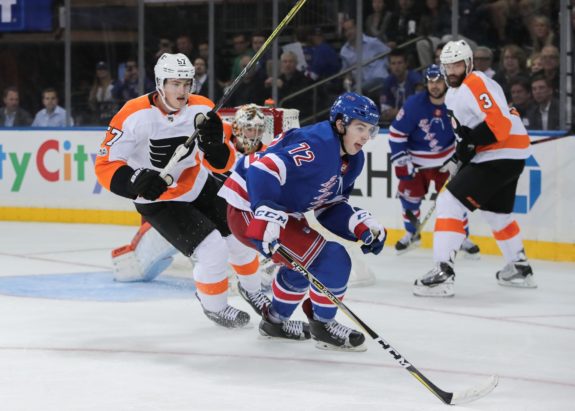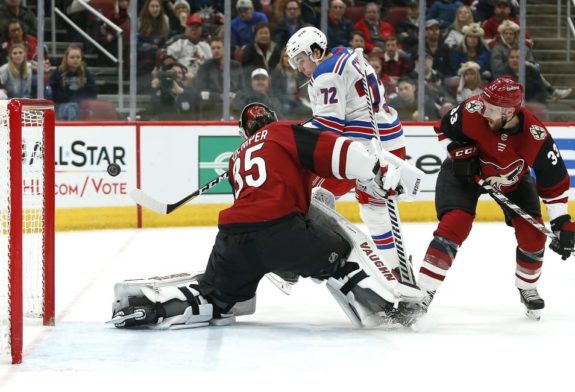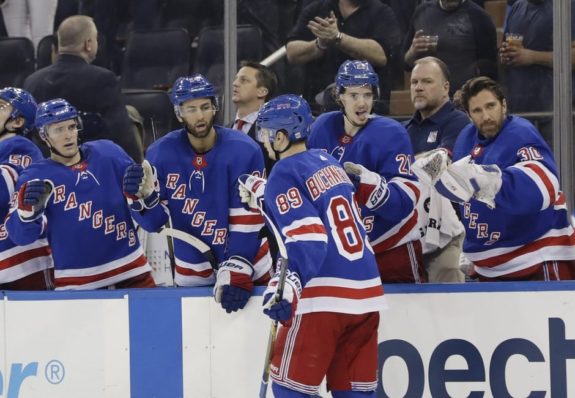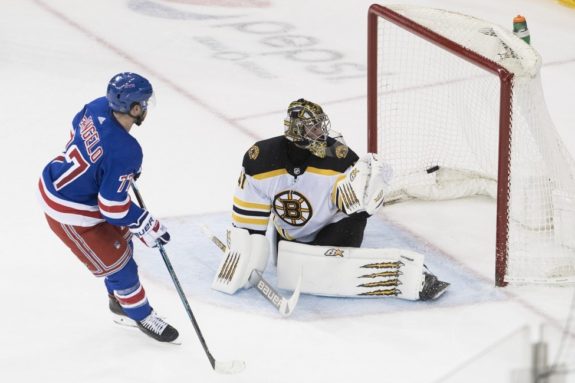The New York Rangers community made phenomenal progress this season in terms of the rebuild process. While there were plenty of struggles with this rebuilding team during the season, there were several bright spots from the young talent that should keep fans’ interest heading into the offseason and into 2019-20.
Guys like Mika Zibanejad and Chris Kreider definitely were leaders of the team, but the success of this rebuild is nothing without taking young talent and turning them into the best pros possible. While not every player the Rangers acquired during this process could be great all the time, if they even turn out to succeed and fit the mold, there were several young guns who benefited this season’s team.

For the following three players, this season was a one of progress, going from concern and impatience to production and growth. They were prime examples of the “peaks and valleys” for young guys in the game that head coach David Quinn has often talked about during the season.
This isn’t to say others have not, but these three are pretty notable examples, and fans should keep an eye out on these guys in the future.
Filip Chytil
Who remembers when Filip Chytil was one of the targets of people’s frustrations at the start of 2018-19? After spending most of 2017-18 with the Hartford Wolf Pack, there were plenty of big expectations for the 19-year-old drafted 21st overall in the 2017 NHL Entry Draft.
Chytil struggled to contribute and find his place early on, much to the disappointment of fans. There were calls for Chytil to be moved back down to Hartford, which also would have extended his rookie contract another season. But Quinn and Rangers brass were determined to make things work and kept their faith.

Then, Chytil broke through during a Nov. 12 showdown with the Vancouver Canucks. This started a historic five-game goal streak, as Chytil became the first teen in team history — 20th in NHL history and seventh since 2005-06 — to score a goal in at least five straight games.
The Czech forward ultimately ended the season with 23 points — 11 goals and 12 assists. While those numbers don’t scream success, that’s as well as Tyler Seguin, Ryan Johansen, Ryan O’Reilly and Sean Couturier did in their first full NHL seasons at his age.
Chytil showed promise while bouncing around between center and wing when Quinn tried to mix around the lineups. And while he didn’t add a large sum of points following the trade deadline, Chytil handled himself well in the extra ice time and showed the capability of playing top minutes.
Related: Rangers’ Future Is as Bright as Can Be
If there are two positives to take away from Chytil’s 2018-19, it’s that he’s just 19 years old. There’s plenty of time for development and growth, and if the Rangers are patient with him and he meets his goals, he could turn into a nice asset of the team’s next core.
Pavel Buchnevich
Pavel Buchnevich finished as the best offensive provider outside of the Zibanejad-Kreider combination (and the traded Kevin Hayes), but there was a point in 2018-19 where things looked bleak.

Buchenvich had a decent start to the season, with some mini hot streaks mixed with non-productive nights, but a thumb injury caused him to miss a month of action. From there, Buchnevich was not in Quinn’s favor, as the first-year coach often demoted him to fourth line or scratched him with his “tough love” approach. It seemed Buchnevich wasn’t doing enough of the quick and aggressive style, and he wanted the Russian to become more than what he thought he was capable of.
Enter the second half of the season, and Buchnevich went into a polar opposite direction, ending the season with 38 points — 21 goals and 17 assists, third on the team in the former two categories. What ultimately led to his success was a willingness to get dirty and aggressive after the net, either getting in his own shot or helping to set his teammates up for theirs.
His 2.5 shots per game in the last 25 games of the season is a much higher average than his entire first half and his turnaround got him back into first-line play and minutes. If the recently-turned 24-year-old is able to turn his half-season performance into a whole season, the sky could be the limit for this young man.
Tony DeAngelo
The patience of fans and members of Rangers brass for Tony DeAngelo may have been growing thin heading into this season. After playing a little less than half the 2016-17 season with the Arizona Coyotes, DeAngelo played just 32 games for the Blueshirts in 2017-18 before demotion and injury. It didn’t help there were questions about his maturity as well.
But after playing a full NHL season for the first time, many are hoping this season was a turning point for the 2017 draft pick.

Things didn’t start this way, as DeAngelo started on a bad foot, providing little to nothing, and faced Quinn’s wrath and benchings. But as the season went on, things started to improve, and DeAngelo ultimately played 61 games this season with 26 assists, tied for second-most on the team. He also finished as one of six Rangers with a plus/minus rating in the positive side.
It appears that Quinn’s no-nonsense approach to coaching this team may have helped guide DeAngelo to turning things around, and it seemed the second half of the season saw less sloppy play and fewer mistakes in the defensive zone.
Questions of maturity and leadership remain to be seen, but it’s a good sign to see aggression in his play — the kind Quinn wants — and his intensity in standing up for his teammates and fighting to fire them up.
If this season was make-or-break for DeAngelo, who will be a restricted free agent this offseason, then the Rangers should give him another chance. If DeAngelo plays as he did in the second half, imagine what he can do for a full season.
Related: Rangers Gear up for Exciting, Pivotal Offseason
This past season showed just how important this development time is for this young Rangers team. The three men mentioned here, along with others, have shown at least flashes of what they can accomplish. While it’s not the perfect time for winning big — there’s still more rebuild ahead — it’s an exciting time to see how these athletes grow.